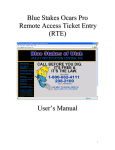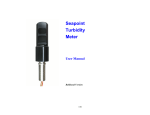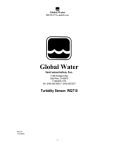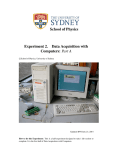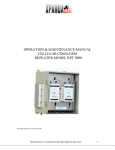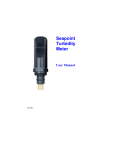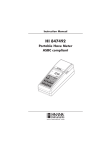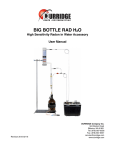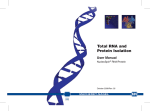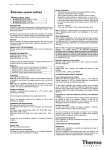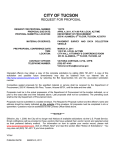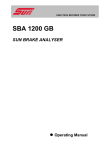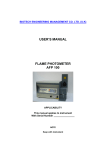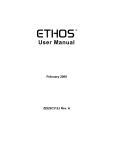Download Turbidity Field Measurement Standard Operating Procedure
Transcript
Turbidity Field Measurement Standard Operating Procedure January 2013 Nez Perce Soil and Water Conservation District PO Box 131 Culdesac, Idaho 83524 208-843-2931 [email protected] www.nezperceswcd.org Standard Operation Procedures for Manual Field Measurement of Turbidity 2013 Introduction The Nez Perce Soil and Water Conservation District (NPSWCD) conducts field measurements of turbidity for project purposes and construction site discharge documentation. This Standard Operating Procedures (SOPs) document provides direction on how to perform turbidity measurements for NPSWCD activities. Responsible Personnel The following personnel are responsible for various aspects associated with turbidity measurements for NPSWCD activities. The brief descriptions provided below serve to clarify the roles that these individuals have in this process. o District Manager is responsible for authorizing all work, and ensures that SOP implementation and documentation responsibilities are clearly communicated to the project personnel. o Construction Inspector is responsible for ensuring that the SOP is implemented and documented for construction projects requiring discharge monitoring. In addition he/she will ensure that measurements are taken on the required schedule and that the designated NPSWCD personnel are performing these requirements in a timely manner. o Planner and/or Field Director is responsible for providing the direction to field crew to perform the data collection and analysis according to the required project frequency. o Field Crew are responsible for performing SOPs, clearly documenting data, and relaying data and observations collected from monitoring activities. Frequency of SOP Meter calibration and measurement procedures described in this SOP must be followed each day that field measurements are performed. References to Existing Source Documents This SOP references the LaMotte 2020we/wi Portable Turbidimeter User Manual1 located in Appendix 1 of this procedure. 1 file:///S:/D290_Inventory/D290_T%20Turbidity%20Monitoring/Reports/LaMotte2020weTurbidityMeterMan ual.html 2 Standard Operation Procedures for Manual Field Measurement of Turbidity 2013 This SOP is also adapted from information provided in the following sources: (1) Standard Operating Procedures for Manual Field Measurement of Turbidity, pH, Dissovled Oxygen, and Conductivity. Final Report. 2012. Caltrans Division of Enviornmenal Analysis, MS 27. PO Box 942874, Sacramento, CA 94272-0001. available for download at: http://www.dot.ca.gov/hq/construc/stormwater/Caltrans_SOPs_CD.pdf Special Cautions and Considerations; Health and Safety Proper gloves must be worn to both prevent alteration of the field measurements, and to protect sampling personnel from environmental hazards. The user should wear at least one layer of gloves, but two layers help protect against leaks. All gloves must be powderfree. Disposable polyethylene, nitrile, or non-talc latex gloves are acceptable for field measurements. CAUTIONS When performing measurements in areas of unknown water quality, especially in waters that are suspected to contain hazardous substances or human pathogens, at least one layer of gloves shall be of the “long-cuff” variety to cover the wrist and forearm to limit skin contact with the source water. 3 Standard Operation Procedures for Manual Field Measurement of Turbidity 2013 Methods/Procedures This SOP pertains to manual measurement of turbidity in the field only. Equipment For field measurement of turbidity at NPSWCD sites, the specified equipment is the LaMotte Portable Turbidimeter, Model 2020we, which is equipped with a complete kit ready for turbidity measurement in the field. Other equipment items also are required for personal safety, sample collection, field data recording, and Quality Control purposes. A complete list of required equipment for field measurement of turbidity is provided in the checklist below. Standard Equipment and Supplies Checklist o Hardhat o Safety vest o Box of powder-free gloves o o o o o Long-cuff gloves as necessary Scientific Calculator “Write-In-The-Rain” Notebook Field Meter Calibration Record Form Field Measurement Data Form o o o o o o Pencil(s) & Pen(s) Digital Camera Flashlight Extra batteries Deionized water for rinsing and cleaning Turbidity Standards (20 NTU, 100 NTU, and 800 NTU) o Manufacturer provides-cloth or lint-free tissues o Manufacturer provides-oiling tissue o Manufacturer provides-silicon oil cleaning solution (refractive index should match that of the sample cells) o Sample Collection Containers o Sample Collection Extension Arm (as required) o LaMotte 2020we Portable Turbidimeter 4 Standard Operation Procedures for Manual Field Measurement of Turbidity 2013 Field Meter Calibration All field meters must be calibrated prior to use. Calibration shall be performed at a minimum of once per day for each day of instrument use. Calibration shall be performed prior to the first measurements of the day. Refer to pages 36 through 37 of the LaMotte 202we Portable Turbidimeter User Manual (Attachment 1) for specific calibration instructions. The LaMotte 2020we turbidity meter calibration is accomplished with three standards provided in the meter kit by the manufacturer. Start the calibration process by pushing the “Calibration” key to enter the calibration mode. Follow the instructions on the display. The calibration is performed using the 0.0 NTU, 1.0 NTU, and 10.0 NTU standards (in that order). To ensure that the standard solutions are well-mixed, gently invert each standard before inserting into the meter. For best accuracy, use the same sample cell or four matched sample cells for all readings during calibration. Insert the sample cell in the instrument cell compartment so that the diamond or orientation mark aligns with the raised orientation mark in front of the cell compartment. Record the results of the field meter calibration on the Turbidity Meter Calibration Record form (see Attachment 2). Sample Collection The LaMotte 2020we turbidity meter requires collection of a sample for subsequent turbidity measurement within the confines of the meter. The sample may be collected using any clean container. A wide-mouth sample bottle provided by the laboratory is preferred for this purpose, as those bottles are shipped pre-cleaned. Samples for field measurement purposes are collected by direct submersion of the sample container into the flow whenever possible. Samples always should be collected upstream of sampling personnel and equipment, and with the sample container pointed upstream when the container is opened for sample collection. Care must be taken not to sample water downstream of areas where sediments have been disturbed in any manner by field personnel. Samples are collected from a location where the sample stream visually appears to be completely mixed. Ideally this is at the centroid of the flow cross-section, but site conditions do not always allow centroid collection. (“Centroid” is defined as the midpoint of that portion of the stream width, which contains 50 percent of the total flow area.) The location should preferably be accessible by direct reach, or in the case of a receiving water body, via wading. If the centroid of the flow cannot be sampled by direct reach or by wading into the flow, a sampling pole or other sampling device can be used to reach the sampling location. Such devices typically involve a means to extend the reach of the sampler, with the sample bottle 5 Standard Operation Procedures for Manual Field Measurement of Turbidity 2013 attached to the end of the device for filling at the desired location. These methods do not allow opening of the sample container under water; therefore, there is potential for contamination when the container is opened prior to lowering the sample container into the stream. Caution is required when wading, as flowing water provides more force than visually anticipated. Only experienced personnel should perform this collection technique. When sampling from a stream bank where direct reach is not possible, the sample container is secured by a hardware device, which, in turn, is attached to the end of an extendable sampling pole. Sites accessed by bridge also can be sampled with a sample container secured to a device, lowered into the stream at the end of a rope. Extreme care must be taken to avoid contaminating the sample with debris from the rope and bridge. Sample Collection Depth: Sub-Surface Sample: Grab samples for field measurements are typically collected at 4 inches below the water surface. Surface Sample: Grab samples for field measurements are collected at the surface when water depth is 4 inches. Because there can be differences in water quality on the surface, compared to subsurface, surface samples should be noted on the field data sheet as collected at 0 inch. After the sample is collected, it must be transferred as soon as possible to the “sample cell” (small glass container) provided in the LaMotte 202we kit. The sample cell then is placed into the meter for turbidity measurement. During this process care must be taken to avoid settling of any material that is suspended in the sample. Settling can be prevented by swirling the sample. Field Measurement Methods When using the LaMotte 2020we turbidity meter for measurement of turbidity, samples must be collected using a clean container, and the instructions presented on pages 9 through 61 of the LaMotte 2020 we Portable Turbidimeter User Manual (Attachment 1) must be followed for sample preparation and analysis. The LaMotte 2020we turbidity meter measures turbidity as nephelometric turbidity units (NTU). The following general instructions must be observed: During Use: Place the meter on a level, stationary surface during measurement. Note: Do not hold the meter in the hand during measurement. Avoid contamination of sample from construction site dust or any other source. 6 Standard Operation Procedures for Manual Field Measurement of Turbidity 2013 Avoid dilution of sample from rain water. Avoid operation in direct sunlight; shade the meter during operation. Measure samples immediately to prevent temperature changes and settling. Before taking a measurement, always ensure that the sample is homogeneous throughout. Always close the sample compartment lid during measurement, calibration, and storage to prevent the entry of dust and dirt. Always cap the sample cell to prevent spillage of the sample into the instrument. Always use clean sample cells in good condition. Dirty, scratched, or damaged cells can cause inaccurate readings. Make sure that cold samples do not “fog” the sample cell. After Use: Store sample cells filled with laboratory-provided distilled or deionized (DI) water and cap tightly. Remove sample cell and batteries from the instrument if the instrument is stored for an extended time period (longer than a month). To perform measurement: 1. Collect a representative sample in a clean container. Fill a sample cell to the line (about 15 milliliter). Take care to handle the sample cell by the top. Cap the cell. 2. Wipe the cell with a soft, lint-free cloth to remove water spots and fingerprints. 3. Apply a thin film of silicone oil (provided in meter kit). Wipe with soft cloth (provided in meter kit) to obtain an even film over the entire surface. 4. Push the “Power” key to turn on the meter. Place the instrument on a flat, sturdy surface. Note: Do not hold the instrument during measurement. 5. Gently invert the sample cell to ensure mixing, and then insert the sample cell in the instrument cell compartment so the diamond or orientation mark aligns with the raised orientation mark in front of the cell compartment. Close the lid. 6. Push the “Read” key. The display shows “Stabilizing” then displays the turbidity in NTU (FNU). The result is stored in the meter automatically. After measurement, complete the CEM-2052 Stormwater Sample Field Test Report form (see Attachment 3). After use, rinse the sample cells with DI water. Store the sample cells with caps on to prevent cells from drying. Do not air dry the sample cells after use. 7 Standard Operation Procedures for Manual Field Measurement of Turbidity 2013 To properly store the sample cells: 1. Fill the sample cells with DI water. 2. Cap and store the sample cells. 3. Wipe the outside of the sample cells dry with a soft cloth. Before leaving the sampling site, field personnel should review datasheets to ensure that they are complete and legible, and that all sampling-related materials and equipment have been collected. Maintenance The meter is designed to be maintenance-free and does not require regular cleaning for normal operation. Exterior surfaces of the meter maybe cleaned as necessary. Clean the meter with a dust- and lint-free dry or slightly damp cloth. A mild soap solution can also be used for liposoluble (greasy/oily) contamination. Note: Do not clean the meter with solvents to avoid damaging the material. Quality Assurance/Quality Control Perform all required QA/QC measures as specified in the Caltrans Construction Site Monitoring Program Guidance Manual. Adherence to the sample collection and measurement procedures described above, along with adherence to QA/QC measures required per the Caltrans Construction Site Monitoring Program Guidance Manual, will ensure that field measurements are representative of environmental conditions, and conform to CGP requirements. Troubleshooting Refer to manufacturer-provided literature for troubleshooting suggestions or call manufacturer’s representative for specific questions. 8 Standard Operation Procedures for Manual Field Measurement of Turbidity 2013 Attachment 1 – LaMotte Portable Turbidimeter 2020we User Manual 9 2020 we/wi 1970-EPA 1970-ISO CONTENTS GENERAL INFORMATION Packaging and Delivery General Precautions Safety Precautions Limits of Liability Specifications Statistical & Technical Definitions Contents and Accessories EPA Compliance ISO Compliance CE Compliance IP67 Compliance Warranty Register Your Meter 5 5 5 6 6 7 9 10 10 10 10 10 10 COMPUTER CONNECTION 11 BATTERY/AC OPERATION 11 TURBIDITY What is Turbidity? How is Turbidity Measured? Turbidity Units Taking Turbidity Water Samples Sample Dilution Techniques 13 13 15 16 17 OPTIONS & SETUP Factory Default Settings Averaging Turbidity Options 17 18 20 Selecting Turbidity Units Selecting a Turbidity Calibration Curve Setting Clock Setting Power Save Setting Backlight Time Factory Reset Selecting Language 20 22 24 26 28 30 32 DATA LOGGING 34 CALIBRATION & ANALYSIS Calibration 36 Turbidity Standards Turbidity Calibration Procedure 36 37 Analysis without Blanking Procedure Analysis with Blanking Procedure 41 43 Dilution Procedure Preparation of Turbidity-Free Water Testing Tips 46 47 48 TROUBLESHOOTING GUIDE Troubleshooting Stray Light 50 50 GENERAL OPERATING INFORMATION Overview The Keypad The Display and Menus Negative Results Tubes and Chambers 51 52 52 54 54 MAINTENANCE Cleaning Repairs Meter Disposal 55 55 56 Refer to the Quick Start Guide for simplified Calibration and Analysis procedures. Refer to the Testing Guide for detailed Calibration and Analysis procedures for improving the accuracy of low range turbidity measurements. 4 GENERAL INFORMATION PACKAGING AND DELIVERY Experienced packaging personnel at LaMotte Company assure adequate protection against normal hazards encountered in transportation of shipments. After the product leaves LaMotte Company, all responsibility for safe delivery is assured by the transportation company. Damage claims must be filed immediately with the transportation company to receive compensation for damaged goods. GENERAL PRECAUTIONS READ THE INSTRUCTION MANUAL BEFORE ATTEMPTING TO SET UP OR OPERATE THE METER. Failure to do so could result in personal injury or damage to the meter. The meter should not be used or stored in a wet or corrosive environment. Care should be taken to prevent water from wet tubes from entering the meter chamber. NEVER PUT WET TUBES IN THE METER. SAFETY PRECAUTIONS Read the label on all reagent containers. Some labels include precautionary notices and first aid information. Certain reagents are considered potential health hazards and are designated with a * in the instruction manual. To view or print a Material Safety Data Sheet (MSDS) for these reagents go to www.lamotte.com. To obtain a printed copy, contact LaMotte by e-mail, phone or FAX. Additional information for all LaMotte reagents is available in the United States, Canada, Puerto Rico, and the US Virgin Islands from Chem-Tel by calling 1-800-255-3924. For other areas, call 813-248-0585 collect to contact Chem-Tel’s International access number. Each reagent can be identified by the four-digit number listed on the upper left corner of the reagent label, in the contents list and in the test procedures. 5 LIMITS OF LIABILITY Under no circumstances shall LaMotte Company be liable for loss of life, property, profits, or other damages incurred through the use or misuse of their products. SPECIFICATIONS - 2020we/wi Instrument Type: Nephelometer Standard: EPA 180.1, 2020we; ISO 7027, 2020wi Units of Measure: NTU (Nephelometric Turbidity Units) (2020we only) FNU (Formazin Nephelometric Units) (2020wi only) ASBC (American Society of Brewing Chemists) EBC (European Brewery Convention) Range: 0-4000 NTU, 0-4000 FNU, 0-10,500 ASBC, 0-150 EBC Range Selection: Automatic Resolution: (display) 0.01 NTU/FNU, 0–10.99 NTU/FNU Range 0.1 NTU/FNU, 11.0–109.9 NTU/FNU Range 1 NTU/FNU, 110–4000 NTU/FNU Range Accuracy: From 0-2.5 NTU/FNU the accuracy is ±0.05 NTU/ FNU. From 2.5-100 NTU/FNU the accuracy is ±2%. Above 100 NTU/FNU the accuracy is ±3%. Detection Limit: 0.05 NTU/FNU Light Source: Tungsten lamp 2300°C ±50 °C, 2020we; IR LED 850 nm ±10 nm, spectral bandwidth 50 nm, 2020wi Detector Photodiode, centered at 90°, maximum peak 400600 nm, 2020we Photodiode, centered at 90°, 2020wi Response Time: <2 seconds Signal Averaging: Yes Sample Chamber: Accepts 25 mm flat-bottomed test tubes Sample: 10 mL in capped tube Display: Graphic Liquid Crystal Display Software: Auto Shut-off: 5, 10, 30 min, disabled Calibration: Field adjustable, blank and 1 point Data Logging: 500 points Languages: English, Spanish, French, Portuguese, Italian, Chinese, Japanese (Kana) Temperature: Operation: 0–50 °C; Storage: -40–60 °C 6 Operation Humidity Range: 0–90 % RH, non-condensing Auto Shut-off: 5, 10, 30 min, disabled Waterproof: IP67 with USB port plug in place. Power Source†: USB wall adapter, USB computer connection or Lithium ion rechargeable battery 2200 mAH, 3.7V Battery: Charge Life: Approximately 380 tests with backlight on to 1000 tests with backlight off. (Signal averaging disabled). Battery Life: Approximately 500 charges. Electrical Ratings: Provided on nameplate label Dimensions: (W x L x H) 8.84 x 19.05 x 6.35 cm; 3.5 x 7.5 x 2.2 inches Weight: 362 g, 13 oz (meter only) USB Interface mini B CE Mark: The device complies to the product specifications for the Low Voltage Directive. † STATISTICAL & TECHNICAL DEFINITIONS RELATED TO PRODUCT SPECIFICATIONS Method Detection Limit (MDL): “The method detection limit (MDL) is defined as the minimum concentration of a substance that can be measured and reported with 99% confidence that the analyte concentration is greater than zero and is determined from analysis of a sample in a given matrix containing the analyte.”1 Note that, “As Dr. William Horwitz once stated, ‘In almost all cases when dealing with a limit of detection or limit of determination, the primary purpose of determining that limit is to stay away from it.’”2 Accuracy: Accuracy is the nearness of a measurement to the accepted or true value.3 The accuracy can be expressed as a range, about the true value, in which a measurement occurs (i.e. ±0.5 ppm). It can also be expressed as the % recovery of a known amount of analyte in a determination of the analyte (i.e. 103.5 %). Resolution: Resolution is the smallest discernible difference between any two measurements that can be made.4 For meters this is usually how many decimal places are displayed. (i.e. 0.01). Note that the resolution many change with concentration or range. In some cases the resolution may be less than the smallest interval, if it is possible to make a reading that falls between calibration marks. A word of caution, that resolution has very little relationship to accuracy or precision. The resolution will always be less than the accuracy or precision but it is not a statistical measure of how well a method of analysis works. The resolution can be very, very good and the accuracy and precision can 7 be very bad! This is not a useful measure of the performance of a test method. Repeatability: Repeatability is the within-run precision.5 A run is a single data set, from set up to clean up. Generally, one run occurs on one day. However, for meter calibrations, a single calibration is considered a single run or data set, even though it may take 2 or 3 days. Reproducibility: Reproducibility is the between-run precision.6 Detection Limit (DL): The detection limit (DL) for the 2020we/wi is defined as the minimum value or concentration that can be determined by the meter, which is greater than zero, independent of matrix, glassware, and other sample handling sources of error. It is the detection limit for the optical system of the meter. 1 CFR 40, part 136, appendix B 2 Statistics in Analytical Chemistry: Part 7 – A Review, D. Coleman and L Vanatta, American Laboratory, Sept 2003, P. 31. 3 Skoog, D.A., West, D. M., Fundamental of Analytical Chemistry, 2nd ed., Holt Rinehart and Winston, Inc, 1969, p. 26. 4 Statistics in Analytical Chemistry: Part 7 – A Review, D. Coleman and L Vanatta, American Laboratory, Sept 2003, P. 34. 5 Jeffery G. H., Basset J., Mendham J., Denney R. C., Vogel’s Textbook of Quantitative Chemical Analysis, 5th ed., Longman Scientific & Technical, 1989, p. 130. 6 Jeffery G. H., Basset J., Mendham J., Denney R. C., Vogel’s Textbook of Quantitative Chemical Analysis, 5th ed., Longman Scientific & Technical, 1989, p. 130 8 CONTENTS & ACCESSORIES 2020we Kit 2020wi Kit EPA Version ISO Version Code 1970-EPA Code 1970-ISO Contents Code Code 0 NTU Standard, 60 mL 1480 1480 1 NTU/FNU Standard, 60 mL 1450 1453 10 NTU/FNU Standard, 60 mL 1451 1454 Water Sample Bottle, 60 mL 0688 0688 Tubes, 6 — — Cable, USB, 3 ft. 1720 1720 USB Wall Adapter 1721 1721 Accessories Code Description 1452 100 NTU Standard, 60 mL (EPA) 1455 100 FNU Standard, 60 mL (ISO) 0290-6 Tubes, Code 0290, Set of 6 3-0038 Replacement Chamber 4185 Turbidity-Free Water Kit 2-2097 Filters, 0.1 micron, Pack of 50 1901-CD SMARTLink 3 Software 5-0132 Car Charger 9 EPA COMPLIANCE The 2020we meter meets or exceeds EPA design specifications for NPDWR and NPDES turbidity monitoring programs as specified by the USEPA method 180.1. ISO Compliance This 2020wi meter meets or exceeds ISO design criteria for quantitative methods of turbidity using optical turbidimeters as specified by ISO 7027. CE COMPLIANCE The 2020we and 2020wi meters have been independently tested and have earned the European CE Mark of compliance for electromagnetic compatibility and safety. To view certificates of compliance, go to the LaMotte website at www.lamotte.com. NOTE: The device complies to the product specifications for the Low Voltage Directive. IP67 COMPLIANCE The 2020we/wi meets IP67 standards for protection against dust and immersion only when the USB port plug is in place. Documentation is available at www.lamotte.com. WARRANTY LaMotte Company warrants this instrument to be free of defects in parts and workmanship for 2 years from the date of shipment. If it should become necessary to return the instrument for service during or beyond the warranty period, contact our Technical Service Department at 1-800-344-3100 for a return authorization number or visit www.lamotte.com for troubleshooting help. The sender is responsible for shipping charges, freight, insurance and proper packaging to prevent damage in transit. This warranty does not apply to defects resulting from action of the user such as misuse, improper wiring, operation outside of specification, improper maintenance or repair, or unauthorized modification. LaMotte Company specifically disclaims any implied warranties or merchantability or fitness for a specific purpose and will not be liable for any direct, indirect, incidental or consequential damages. LaMotte Company’s total liability is limited to repair or replacement of the product. The warranty set forth above is inclusive and no other warranty, whether written or oral, is expressed or implied. REGISTER YOUR METER To register your meter with the LaMotte Service Department, go to www.lamotte.com and choose SUPPORT on the top navigation bar. 10 COMPUTER CONNECTION PC LINK The 2020we/wi may be interfaced with any Windows-based computer by using the LaMotte SMARTLink 3 Program and USB Cable. The program will store test information and results in a database. To transfer data from the meter to a computer, plug the smaller end of the USB cable (USB mini B connector) into the meter and the larger end of the USB cable (USB Type A connector) into a USB port on a computer. The 2020we/ wi will send the following data: test name, wavelength, concentration, transmittance, absorbance, sample, blank, time of test, and date of test. OUTPUT USB COMPUTER CONNECTION USB Type A, USB mini B, Order Cable Code 1720. BATTERY/AC OPERATION The 2020we/wi may be operated on battery power or using USB wall adapter or USB computer connection. If using the meter as a bench top unit, use the wall adapter if possible to extend the battery life. The meter will remain on when the USB adapter is used. To charge the battery with the wall adapter, plug the smaller end of the USB cable (USB mini B connector) into the meter and the larger end of the USB cable (USB Type A connector) into the wall adapter. Plug the wall adapter into an AC outlet. Reinsert the USB port plug after charging. To charge the battery from a computer, plug the smaller end of the USB cable (USB mini B connector) into the meter and the larger end of the USB cable (USB Type A connector) into a USB port on a computer. Reinsert the USB port plug after charging. The battery icon will show no bars and flash when the unit first turns on. Then the indicator will indicate the battery status by showing 0, 1, 2, 3 or 4 bars. It will take 5 hours to fully charge a low battery. The battery icon will flash when the battery is charging. The battery icon will show four bars and stop flashing when it is fully charged. The charging circuit will automatically switch to a float charge when the battery is fully charged. The charger may remain connected. Some computers will NOT supply power to their USB ports during standby operation. The wall adapter will charge the unit continuously. The battery icon will show no bars and continuously flash if the battery is getting low but the unit will still operate normally. A “Low Battery” message on the status bar of the display will replace the time when the battery voltage is too low for proper operation and accuracy may be degraded. A “Shutdown Low Batt” message on the display will appear for a few seconds before the power is switched off when the battery is too low to operate the unit. 11 To extend the battery life: • Shut down the unit with the power switch when not taking measurements or use the power save option to have the unit automatically turn off after 5 minutes. • Store the unit in a cool dry place. • Fully charge the battery before storing the unit for extended periods of time. • Limit backlight use. The unit consumes 3X normal power with the backlight on. Set the backlight time option to 10 seconds, or select “Button Control” and keep the backlight off. Battery replacement: The lithium-ion battery used in this unit should last for many years with normal use. When it no longer powers the unit long enough to meet testing requirements it will need to be replaced. Lithium-ion batteries that are properly charged and stored do not usually lose all capacity; they just have less capacity after hundreds of charge cycles. This unit uses a custom battery assembly that is only available from LaMotte Company. Battery replacement must be performed at a LaMotte authorized repair facility. The water resistant housing of this meter should not be opened by the user. Contact LaMotte Company by phone (1-800-344-3100) or email ([email protected]) for a return authorization number. 12 TURBIDITY WHAT IS TURBIDITY? Turbidity is an aggregate property of the solution, which is water in most cases. Turbidity is not specific to the types of particles in the water. The particles could be suspended or colloidal matter, and they can be inorganic, organic or biological. At high concentrations, turbidity is perceived as cloudiness, haze or an absence of clarity in the water. Turbidity is an optical property that results when light passing through a liquid sample is scattered. The scattering of light results in a change in the direction of the light passing through the liquid. This is most often caused when the light strikes particles in solution and is scattered backward, sideways and forward. If the turbidity is low, much of the light will continue in the original direction. Light scattered by the particles allows the particle to be ”seen” or detected in solution just as sunlight allows dust particles in the air to be seen. In the past 10 years, turbidity has become more than just a measure of water clarity. Because of the emergence of pathogens such as Cryptosporidium and Giardia, turbidity now holds the key to assuring proper water filtration. In 1998, the EPA published the IESWTR (interim enhanced surface water treatment rule) mandating turbidities in combined filter effluent to read at or below 0.3 NTU. By doing so, the EPA hoped to achieve a 2 log (99%) removal of Cryptosporidium. There is presently consideration to lower this to 0.1 NTU. The trend has been to check the calibration of on-line turbidimeters with hand-held field units. The optical design and low detection limit of the 2020we/wi allows very accurate readings for such calibrations. The meter also allows the user to choose the units of measure for expressing turbidity. While nephelometric turbidity unit (NTU) has been the standard for years, FNU (formazin nephelometric unit) and FAU (formazin attenuation unit) are now being used in ISO 7027 units. American Society of Brewing Chemists (ASBC) units and European Brewery Convention (EBC) units allow the brewing industry to check process waters. HOW IS TURBIDITY MEASURED? Turbidity is measured by detecting and quantifying the scattering of light in water (solution). Turbidity can be measured in many ways. There are visual methods and instrumental methods. Visual methods are more suitable for samples with high turbidity. Instrumental methods can be used on samples with both high and low levels of turbidity. Two visual methods are the Secchi Disk method and the Jackson Candle method. The Secchi Disk method is often used in natural waters. A black and white Secchi Disk is lowered into the water until it can no longer be seen. It is then raised until it can be seen again. The average of these two distances is known as the “Secchi Depth”. The Jackson Candle method uses a long glass tube over a standard candle. Water is added or removed from the tube until the candle flame becomes indistinct. The depth of the water measured with a calibrated scale is 13 reported as Jackson Turbidity Units (JTU). The lowest turbidity that can be determined with this method is about 25 NTU. There are two common methods for instruments to measure turbidity. Instruments can measure the attenuation of a light beam passing through a sample and they can measure the scattered light from a light beam passing through a sample. In the attenuation method, the intensity of a light beam passing through a turbid sample is compared with the intensity passing through a turbidity-free sample at 180° from the light source. This method is good for highly turbid samples. The most common instrument for measuring scattered light in a water sample is a nephelometer. A nephelometer measures light scattered at 90° to the light beam. Light scattered at other angles may also be measured, but the 90° angle defines a nephelometric measurement. The light source for nephelometric measurements can be one of two types to meet EPA or ISO specifications. The EPA specifies a tungsten lamp with a color temperature of 2,200–3,000 K. The units of measurement for the EPA method are nephelometric turbidity units (NTU). The ISO specifies a light emitting diode (LED) with a wavelength of 860 ± 30 nm and a spectral bandwidth less than or equal to 60 nm. The units of measurement for the ISO method are formazin nephelometric units (FNU). The 2020we meets the EPA specification and the 2020wi meets the ISO specification. The nephelometric method is most useful for low turbidity. The 2020we/wi is a nephelometer that is capable of measuring turbidity by both the attenuation method and the nephelometric method. It uses a detector placed at 180° to the light source for high turbidity samples. It uses a detector placed at 90° to the light source for the nephelometric method for low turbidity samples. The 2020we/wi has a signal averaging option to improve the stability of readings on low turbidity samples. The 2020we/wi has two different turbidity calibrations, formazin and Japan Standard. The formazin calibration is the EPA and ISO approved method of calibrating nephelometers. This calibration can be used with user prepared formazin standards or commercially purchased formazin standards. LaMotte Company approved AMCOTM standards labeled for use with the 2020we/wi can also be used with the formazin calibration. Stablcal® standards below 50 NTU should not be used to calibrate the 2020we/wi. The Japan Standard calibration is a calibration for a Japanese Water Works standard. It is based on Japanese formulated polystyrene turbidity standards. This calibration should only be used to meet Japanese Water Works requirements. The Japanese polystyrene standards can only be purchased in Japan. Formazin, AMCO and Stablcal® standards cannot be used with this calibration. 14 TURBIDITY UNITS Traditionally, turbidimeters designed for use in the United State were made to the specifications of EPA Method 180.1. This method defined the NTU, nephelometric turbidity unit, as a unit to measure turbidity in the range of 0 – 40 NTU using a nephelometer. According to the EPA a nephelometer was a turbidimeter that measured turbidity with a 90° detector. Also, if the turbidity was greater than 40 NTU, a dilution was necessary to bring the sample into the 0 – 40 NTU range. Today, many turbidimeters have additional detectors which increase the range of the turbidity measurement, eliminate interferences and generally improve the performance. Currently, many turbidimeters are capable of measuring above 40 NTU by using detectors other than a 90° detector. Even though they may use a 180° detector to measure the light that is attenuated by high turbidity samples they may continue to report the results as NTU. Recently there has been an effort to use the units of turbidity measurements to indicate which type of detector and light source was used. For EPA compliant meters, measurements made with a 90° degree detector and an incandescent white light source are reported as NTU. When an attenuation measurement is made with a 180°detector, using the same meter, the results are reported as AU, attenuation units. ISO Method 7027, which specifies a 860 nm light source, also uses two turbidity units. When the 90° degree detector is used, the results are reported as FNU, formazin nephelometric units. With an attenuation measurement made with a 180°detector, the results are reported as FAU, formazin attenuation units. It should be noted that all units are numerically equivalent if the meters are calibrated to formazin and that the units only designate which detector was used to make the measurement. For example, 1 NTU = 1 AU = 1FNU = 1FAU. 15 Options/Set Up Regulatory Method Acronyms Definitions Notes NTU Nephelometric Turbidity Units Incandescent white light between 400 and 600 nm, 90° detection, 2020we FNU Formazin Nephelometric Units IR LED (usually) 860 ISO 7027 nm, bandwidth less than 60 nm, 90° detection, 2020wi AU Attenuation Units Incandescent white light between 400 and 600 nm, 180° detection, 2020we FAU Formazin Attenuation Units IR LED (usually) 860 ISO 7027 nm, bandwidth less than 60 nm, 180° detection, 2020wi ASBC American Society of Brewing Chemists 2020we/wi Not applicable EBC European Brewery Convention 2020we/wi Not applicable EPA 180.1 Not applicable The 2020we and 2020wi each use two turbidity units. The 2020we reports the result as NTU when the 90° detector is used and AU when the 180° detector is used. The 2020wi reports the result as FNU when the 90° detector is used and FAU when the 180° detector is used. TAKING TURBIDITY WATER SAMPLES Clean plastic or glass containers may be used for turbidity samples. Ideally, samples should be tested soon after collection and at the same temperature as when collected. 16 Amount of Sample Deionized Water to Bring Final Volume to 10 mL Multiplication Factor 10 mL 0 mL 1 5 mL 5 mL 2 2.5 mL 7.5 mL 4 1 mL 9 mL 10 0.5 mL 9.5 mL 20 All dilutions are based on a final volume of 10 mL, so several dilutions will require small volumes of the water sample. Graduated pipets should be used for all dilutions. If volumetric glassware is not available, dilutions can be made with the colorimeter tube. Fill the tube to the 10 mL line with the sample and then transfer it to another container. Add 10 mL volumes of deionized water to the container and mix. Transfer 10 mL of the diluted sample to the colorimeter tube and follow the test procedure. Repeat the dilution and testing procedures until the result falls within the range of the calibration. Multiply the test result by the dilution factor. For example, if 10 mL of the sample water is diluted with three 10 mL volumes of deionized water, the dilution factor is four. The test result of the diluted sample should be multiplied by four. OPTIONS & SET UP FACTORY DEFAULT SETTINGS Settings that have user options have been set at the factory to default settings. The factory default settings are: Averaging Disabled Turbidity Units NTU Turbidity Calibration Formazin Date Format MM-DD-YYYY Power Save 5 minutes Backlight 10 seconds Language English 17 Options/Set Up SAMPLE DILUTION TECHNIQUES If a test result is out of the range of the meter, it must be diluted. The test should then be repeated on the diluted sample. The following table gives quick reference guidelines for dilutions of various proportions. Options/Set Up AVERAGING The averaging option allows the user to average multiple readings. This option will improve the accuracy of samples with readings that may tend to drift with time. When the two, five or ten measurement option has been selected the final average is displayed. The default setting is disabled. To change the setting: 1. Press and briefly hold to turn the meter on. The LaMotte logo screen will appear for about 3 seconds and the Main Menu will appear. Main Menu Measure Data Logging Options Run PC Link 12:00:00 2. Press Options. 001/500 Main Menu to scroll to Measure Data Logging Options Run PC Link 12:00:00 3. Press ENTER to select Options. 001/500 Options Menu Averaging Turbidity Options Set Clock Set PWR Save 12:00:00 4. Press ENTER to select Averaging. 001/500 Averaging Menu Disabled 2 Measurements 5 Measurements 10 Measurements 12:00:00 18 001/500 Averaging Menu Disabled 2 Measurements 5 Measurements 10 Measurements 12:00:00 6. Press ENTER to save the selection. The screen will display Storing... for about 1 second and return to the Options Menu. 001/500 Options Menu Averaging Turbidity Options Set Clock Set PWR Save 12:00:00 001/500 NOTE: When the Averaging option is enabled, more time will be required to display a reading and more power will be used. 19 Options/Set Up 5. Press or to scroll to the desired option. Options/Set Up TURBIDITY OPTIONS The default units are NTU and FNU and the default calibration curve is formazin. NTU will be used in this example. To change the settings: Selecting Turbidity Units 1. Press and briefly hold to turn the meter on. The LaMotte logo screen will appear for about 3 seconds and the Main Menu will appear. Main Menu Measure Data Logging Options Run PC Link 12:00:00 2. Press Options. 001/500 Main Menu to scroll to Measure Data Logging Options Run PC Link 12:00:00 001/500 Options Menu 3. Press ENTER to select Options. Press to scroll Averaging to Turbidity Options. Turbidity Options Set Clock Set PWR Save 12:00:00 4. Press ENTER to select Turbidity Options. 001/500 Turbidity Options Turbidity Units Turbidity Calibration 12:00:00 20 001/500 Set Turbidity Units NTU ASBC EBC 12:00:00 001/500 Available units are: NTU (Nephelometric Turbidity Units)( 2020we only) FNU (Formazin Nephelometric Units) (2020wi only) ASBC (American Society of Brewing Chemists) EBC (European Brewery Convention) NOTE: The meter will automatically switch to the attenuation mode above 600 NTU or FNU. In Attenuation mode, measurements will be made with the 180° detector only, as indicated by AU (attenuation units) or FAU (formazin anttenuation units) on the display. AU and FAU are numberically equivalent to NTU. See page 15 for definitions of turbidity units. 6. Press or to scroll to the desired units. Set Turbidity Units NTU ASBC EBC 12:00:00 7. Press ENTER to save the selection. The screen will display Storing... for about 1 second and return to the Turbidity Options menu. Press EXIT to return to a previous menu. 001/500 Turbidity Options Turbidity Units Turbidity Calibration 12:00:00 21 001/500 Options/Set Up 5. Press ENTER to select Turbidity Units. Options/Set Up Selecting a Turbidity Calibration Curve 1. Press and briefly hold to turn the meter on. The LaMotte logo screen will appear for about 3 seconds and the Main Menu will appear. Main Menu Measure Data Logging Options Run PC Link 12:00:00 2. Press Options. to scroll to 001/500 Main Menu Measure Data Logging Options Run PC Link 12:00:00 001/500 Options Menu 3. Press ENTER to select Options. Press to scroll Averaging to Turbidity Options. Turbidity Options Set Options Set PWR Save 12:00:00 4. Press ENTER to select Turbidity Options. 001/500 Turbidity Options Turbidity Units Turbidity Calibration 12:00:00 5. Press to scroll to Turbidity Calibration. 001/500 Turbidity Options Turbidity Units Turbidity Calibration 12:00:00 22 001/500 Turbidity Calibration Formazin Japan Standard 12:00:00 7. Scroll to the desired calibration option. Select a calibration option based on the composition of the standards that will be used to calibrate the meter. 001/500 Turbidity Calibration Formazin Japan Standard 12:00:00 001/500 NOTE: Stablcal® standards below 50 NTU should not be used to calibrate the 2020we/wi. The diluent has a different refractive index than traditional formazin standards and will affect the results. 8. Press ENTER to save the selection. The screen will display Storing... for about 1 second and return to the Turbidity Options menu. Press EXIT to return to a previous menu. Turbidity Options Turbidity Units Turbidity Calibration 12:00:00 23 001/500 Options/Set Up 6. Press ENTER to select Turbidity Calibration. Options/Set Up SETTING THE CLOCK 1. Press and briefly hold to turn the meter on. The LaMotte logo screen will appear for about 3 seconds and the Main Menu will appear. Main Menu Measure Data Logging Options Run PC Link 12:00:00 2. Press Options. 001/500 Main Menu to scroll to Measure Data Logging Options Run PC Link 12:00:00 001/500 Options Menu 3. Press ENTER to select Options. Press to scroll Averaging to Set Clock. Turbidity Options Set Clock Set PWR Save 12:00:00 001/500 Set Time 4. Press ENTER to select Set Clock. The date is Date: 07-09-2010 displayed as month-day-year. Time: 02:09:08 PM The time is displayed as hours:minutes:seconds AM/PM. Press or to the appropriate character 12:00:00 001/500 and press ENTER to select. The cursor will move to the next character. Set all characters in the same manner. This is a scrolling menu. 24 Options Menu Averaging Turbidity Options Set Clock Set PWR Save 12:00:00 25 001/500 Options/Set Up 5. Press ENTER to select the final character. The time and date will be saved and the screen will return to the Options Menu. Options/Set Up SETTING POWER SAVE The power saving Auto Shutoff feature will turn the meter off when a button has not been pushed for a set amount of time. The default setting is 5 minutes. To change the setting: 1. Press and briefly hold to turn the meter on. The LaMotte logo screen will appear for about 3 seconds and the Main Menu will appear. Main Menu Measure Data Logging Options Run PC Link 12:00:00 2. Press Options. to scroll to 001/500 Main Menu Measure Data Logging Options Run PC Link 12:00:00 3. Press ENTER to select Options. 001/500 Options Menu Averaging Turbidity Options Set Clock Set PWR Save 12:00:00 4. Press to scroll to Set PWR Save. 001/500 Options Menu Averaging Turbidity Options Set Clock Set PWR Save 12:00:00 26 001/500 ENTER to select PWR Auto Shutoff Disable 5 Minutes 15 Minutes 30 Minutes 12:00:00 6. Press or to desired setting. 001/500 Auto Shutoff to scroll Disable 5 Minutes 15 Minutes 30 Minutes 12:00:00 7. Press ENTER to save the selection. The screen will display Storing... for about 1 second and return to the Options Menu. 001/500 Options Menu Averaging Turbidity Options Set Clock Set PWR Save 12:00:00 27 001/500 Options/Set Up 5. Press Save. Options/Set Up SETTING THE BACKLIGHT TIME The backlight illuminates the display for enhanced viewing. If Button Control is chosen the backlight button on the key pad will act as an on/off switch and the backlight will remain on or off when the meter is being used. When one of the other settings – 10, 20 or 30 seconds – is chosen, the display will be illuminated for the specified amount of time after any button is pressed. As a precaution, the backlight will not illuminate during turbidity measurements to avoid interference from stray light. NOTE: The backlight feature uses a significant amount of power. The longer the backlight is on, the more frequently the battery will have to be charged if the USB/Wall Charger is not being used. 1. Press and briefly hold to turn the meter on. The LaMotte logo screen will appear for about 3 seconds and the Main Menu will appear. Main Menu Measure Data Logging Options Run PC Link 12:00:00 2. Press Options. 001/500 Main Menu to scroll to Measure Data Logging Options Run PC Link 12:00:00 3. Press ENTER to select Options. 001/500 Options Menu Averaging Turbidity Options Set Clock Set PWR Save 12:00:00 28 001/500 Options Menu Turbidity Options Set Clock Set PWR Save Set Backlight Time 12:00:00 5. Press ENTER to select Set Backlight Time. 001/500 Backlight Time Button Control 10 Seconds 20 Seconds 30 Seconds 12:00:00 6. Press or to desired setting. 001/500 Backlight Time to scroll Button Control 10 Seconds 20 Seconds 30 Seconds 12:00:00 7. Press ENTER to save the selection. The screen will display Storing... for about 1 second and return to the Options Menu. 001/500 Options Menu Turbidity Options Set Clock Set PWR Save Set Backlight Time 12:00:00 29 001/500 Options/Set Up 4. Press to scroll to Set Backlight Time. Options/Set Up FACTORY RESET Performing a Factory Reset will restore the factory default settings. All user-level calibrated settings will be lost. 1. Press and briefly hold to turn the meter on. The LaMotte logo screen will appear for about 3 seconds and the Main Menu will appear. Main Menu Measure Data Logging Options Run PC Link 12:00:00 2. Press Options. to scroll to 001/500 Main Menu Measure Data Logging Options Run PC Link 12:00:00 3. Press ENTER to select Options. 001/500 Options Menu Averaging Turbidity Options Set Clock Set PWR Save 12:00:00 4. Press to scroll to Factory Reset. 001/500 Options Menu Set Clock Set PWR Save Set Backlight Time Factory Reset 12:00:00 5. Press ENTER to select to Factory Reset. 001/500 Options Menu <Enter> Continue <Exit> to Abort 12:00:00 30 001/500 7. Press ENTER to return to the Options Menu. Options Menu Done <Enter> Continue 12:00:00 001/500 Options Menu Set Clock Set PWR Save Set Backlight Time Factory Reset 12:00:00 31 001/500 Options/Set Up 6. Press ENTER to complete the Factory Reset. The screen will momentarily display Writing. The screen will display Done and return to the Options Menu. To retain the current user level calibration settings, press EXIT to abort the Factory Reset. Options/Set Up SELECTING A LANGUAGE There are seven languages available in the 2020we/wi: English, Spanish, French, Portuguese, Italian, Chinese, and Japanese (Kana). 1. Press and briefly hold to turn the meter on. The LaMotte logo screen will appear for about 3 seconds and the Main Menu will appear. Main Menu Measure Data Logging Options Run PC Link 12:00:00 2. Press Options. to scroll to 001/500 Main Menu Measure Data Logging Options Run PC Link 12:00:00 3. Press ENTER to select Options. 001/500 Options Menu Averaging Turbidity Options Set Clock Set PWR Save 12:00:00 001/500 Options Menu 4. Press to scroll to Select Set PWR Save Language. Set Backlight Time Factory Reset Select Language 12:00:00 5. Press ENTER to select to Select Language. 001/500 Select Language English Spanish French Portuguese 12:00:00 32 001/500 Select Language English Spanish French Portuguese 12:00:00 7. Press ENTER to select desired language. The screen will momentarily display, Storing...for about 1 second and return to the Options Menu. 001/500 Options Menu Set PWR Save aging Set Backlight Time Factory Reset Select Language 12:00:00 001/500 NOTE: If the meter unintentionally switches to another language, use the procedure above to reset the meter to the desired language. For example, to reset the meter to English: 1. Turn the meter on. 2. Press down arrow twice. Press ENTER. 3. Press down arrow seven times. Press ENTER. 4. Press ENTER. 33 Options/Set Up 6. Press or to scroll to desired language. Options/Set Up DATA LOGGING The default setting for the data logger is enabled. The meter will log the last 500 data points. The counter in the center bottom of the display will show how many data points have been logged. The display will show 500+ when the data logger has exceeded 500 points and the data points are being overwritten. 1. Press and briefly hold to turn the meter on. The LaMotte logo screen will appear for about 3 seconds and the Main Menu will appear. Main Menu Measure Data Logging Options Run PC Link 12:00:00 2. Press Logging. to scroll to Data 001/500 Main Menu Measure Data Logging Options Run PC Link 12:00:00 3. Press ENTER to select Data Logging. 001/500 Logging Display Test Log Enable Logging Disable Logging Erase Log 12:00:00 001/500 Record Number 2 4. Press ENTER to display the last data point and the time that it Turbidity - WB (F) was logged. 655 AU 12:26:58 PM 08-03-2010 12:00:00 34 001/500 5. Press or to scroll through the data points in the log. Record Number 1 Turbidity - WB (F) 95.4 NTU 12:26:44 PM 08-03-2010 12:00:00 Logging Display Test Log Enable Logging Disable Logging Erase Log 12:00:00 35 001/500 Calibration 6. Press EXIT to return to the Logging menu. Press or to scroll to disable the logging options or erase the log. Press ENTER to select the option. The screen will display Storing... for about 1 second and return to the Logging Menu. 001/500 CALIBRATION & ANALYSIS Calibration CALIBRATION Turbidity Standards Only use AMCO or formazin standards with the 2020we/wi. StablCal® standards below 50 NTU should not be used to calibrate the 2020we/wi. The diluent used in the StablCal® standards has a different refractive index than traditional formazin standards and will affect the results. The concentration of the calibration standard should be similar to the expected concentration of sample that will be tested. The following standards are available from LaMotte Company: 1480 0 NTU/FNU Standard, 60 mL (EPA or ISO) 1450 1 NTU Standard, 60 mL (EPA) 1453 1 FNU Standard, 60 mL (ISO) 1451 10 NTU Standard, 60 mL (EPA) 1454 10 FNU Standard, 60 mL (ISO) 1452 100 NTU Standard, 60 mL (EPA) 1455 100 FNU Standard, 60 mL (ISO) Turbidity Calibration Procedure The default units are NTU and FNU and the default calibration curve is formazin as indicated by (F) in the Menu bar. A 2020we, which uses NTU, will be used in the following examples. For the most accurate results, a user calibration should be performed. The Japan Standard calibration mode, as indicated by (J) in the Menu bar, should be used only with Japanese Polystyrene Standards (0-100 NTU). To change the settings see the Set Up Instructions on page 9. For the most accurate results, perform a calibration over the smallest range possible. Use a calibration standard that, along with the blank, brackets the range of the samples that will be tested. For example, if the samples that are to be tested are expected to be below 1 NTU, more accurate results will be obtained by calibration with a blank and a 1 NTU standard as opposed to a blank and a 100 NTU standard. The meter has five measuring ranges: 0 – 11 NTU/FTU 11 – 110 NTU/FTU 110-300 NTU/FTU 300-600 NTU/FTU 600-4000 NTU/FTU Each range can be calibrated with one point per range. (Six points total - a blank plus one point in each of the five ranges - if each range is calibrated.) New calibration points will replace old calibration points independently for each range. If one range is recalibrated, the meter will 36 retain the old calibration data for the other ranges. It is recommended that the meter be calibrated for each range that will be used. The value of the standards chosen for the calibration should not be at the extremes of the ranges (11, 110, 300, 600 NTU/FTU). The meter is auto-ranging and will automatically select the appropriate range for the sample being tested. It is recommended that the meter be calibrated daily. Main Menu Measure Data Logging Options Run PC Link 12:00:00 2. Press ENTER to select Measure. 001/500 Measure Menu Turbidity - No Blank Turbidity - With Blank 12:00:00 3. Press to scroll to Turbidity - With Blank. 001/500 Measure Menu Turbidity - No Blank Turbidity - With Blank 12:00:00 001/500 Turbidity WB (F) 4. Press ENTER to select Turbidity - With Blank. Scan Blank Scan Sample 12:00:00 37 001/500 Calibration 1. Press and briefly hold to turn the meter on. The LaMotte logo screen will appear for about 3 seconds and the Main Menu will appear. Calibration 5. Rinse a clean tube (0290) three times with the blank. If samples are expected to read below 1 NTU the meter should be blanked with a 0 NTU Primary Standard or prepared turbidity-free (<0.1 NTU) water. For the most accurate results, use the same tube for the blank and the sample. l 6. Fill the tube to the fill line with the blank. Pour the blank down the inside of the tube to avoid creating bubbles. Cap the tube. 7. Wipe the tube thoroughly with a lint-free cloth. 8. Open the meter lid. Insert the tube into the chamber. Align the index line on the tube with the index arrow on the meter. Close the lid. 38 Turbidity WB (F) 9. Press ENTER to scan the blank. The screen will display Blank Done for about 1 second and then return to the Turbidity Scan Blank With Blank Menu. Scan Sample 12:00:00 001/500 10. Rinse a clean tube (0290), or the same tube, three times with the standard. 11. Fill the tube to the fill line with the standard. Pour the standard down the inside of the tube to avoid creating bubbles. Cap the tube. 12. Wipe the tube thoroughly with a lint-free cloth. 13. Open the meter lid. Insert the tube into the chamber. Align the index line on the tube with the index arrow on the meter. Close the lid. 39 Calibration l Turbidity WB (F) 14. Press ENTER to scan the standard. The screen will display Reading for about 1 second. The result will appear Scan Blank on the screen. Scan Sample 0.99 NTU 12:00:00 Calibration 15. Press to scroll to Calibrate. 001/500 Turbidity WB (F) 0.99 NTU Scan Sample Calibrate 12:00:00 16. Press ENTER to select Calibrate. A reverse font (dark background with light characters) will appear to indicate that the reading can be adjusted. 001/500 Turbidity WB (F) 0.99 Scan Sample Calibrate 12:00:00 17. Press or to scroll to the concentration of the standard, 1.00 in the example. Note: The allowable adjustment is ±20%. 001/500 Turbidity WB (F) 1.00 NTU Scan Sample Calibrate 12:00:00 18. Press ENTER to select Caibrate. Two menu choices will be offered, Set Calibration and Factory Setting. NTU 001/500 Calibrate Menu 1.00 NTU Set Calibration Factory Setting 12:00:00 40 001/500 Turbidity WB (F) 19. Press ENTER to select Set Calibration and save the calibration. Press or to scroll and select Scan Blank Factory Setting to revert to the factory calibration. The Scan Sample meter will momentarily display 12:00:00 001/500 Storing... and return to the Turbidity -Without Blank menu. The calibration has now been saved and the meter can be used for testing. NOTE: For the greatest accuracy during the calibration procedure, be sure that after the meter is blanked and the blank is scanned as a sample, the reading is 0.00. If not, reblank the meter and scan the blank again until it reads 0.00. When scanning the calibration standards as the sample, scan the calibration standard three times removing the tube from the chamber after each scan and reinserting the tube in the chamber with the same orientation. The readings should be consistent. Use the last consistent reading to calibrate the meter. If the readings are not consistent, avoid using an aberrant reading to calibrate the meter. 1. Press and briefly hold to turn the meter on. The LaMotte logo screen will appear for about 3 seconds and the Main Menu will appear. Main Menu Measure Data Logging Options Run PC Link 12:00:00 2. Press ENTER to select Measure. 001/500 Measure Menu Turbidity - No Blank Turbidity - With Blank 12:00:00 41 001/500 Analysis ANALYSIS WITHOUT BLANKING PROCEDURE To obtain the most accurate results the meter should be blanked before measuring a sample. The blanking step is not as critical for samples above 10 NTU. The meter should always be blanked before reading samples below 10 NTU. Turbidity NB (F) 3. Press ENTER to select Turbidity - No Blank. Scan Blank Scan Sample 12:00:00 4. Rinse a clean tube (0290) three times with the sample. l Analysis 5. Fill the tube to the fill line with the sample. Pour the sample down the inside of the tube to avoid creating bubbles. Cap the tube. 6. Wipe the tube thoroughly with a lint-free cloth. 7. Open the meter lid. Insert the tube into the chamber. Align the index line on the tube with the index arrow on the meter. Close the lid. 42 001/500 Turbidity NB (F) 8. Press ENTER to select Scan Sample. The screen will display Reading for about 1 second. The result will appear Scan Blank on the screen. Scan Sample 10.22 NTU 12:00:00 001/500 ANALYSIS WITH BLANKING PROCEDURE To obtain the most accurate results the meter should be blanked before measuring a sample. The blanking step is not as critical for samples above 10 NTU. The meter should always be blanked before reading samples below 10 NTU. 1. Press and briefly hold to turn the meter on. The LaMotte logo screen will appear for about 3 seconds and the Main Menu will appear. Main Menu Measure Data Logging Options Run PC Link 12:00:00 Measure Menu Turbidity - No Blank Turbidity - With Blank 12:00:00 3. Press to scroll to Turbidity - With Blank. 001/500 Measure Menu Turbidity - No Blank Turbidity - With Blank 43 Analysis 2. Press ENTER to select Measure. 001/500 Turbidity WB (F) 4. Press ENTER to select Turbidity - With Blank. Scan Blank Scan Sample 12:00:00 Analysis 5. Rinse a clean tube (0290) three times with the blank. If samples are expected to read below 1 NTU the meter should be blanked with a 0 NTU Primary Standard or prepared turbidity-free (<0.1 NTU) water. For the most accurate results, use the same tube for the blank and the sample. l 6. Fill the tube to the fill line with the blank. Pour the blank down the inside of the tube to avoid creating bubbles. Cap the tube. 7. Wipe the tube thoroughly with a lint-free cloth. 44 001/500 8. Open the meter lid. Insert the tube into the chamber. Align the index line on the tube with the index arrow on the meter. Close the lid. Turbidity WB (F) 9. Press ENTER to scan the blank. The screen will display Blank Done for about 1 second and then return to the Turbidity Scan Blank With Blank menu. Scan Sample 12:00:00 001/500 10. Rinse a clean tube (0290), or the same tube, three times with the sample. l Analysis 11. Fill the tube to the fill line with the standard. Pour the standard down the inside of the tube to avoid creating bubbles. Cap the tube. 12. Wipe the tube thoroughly with a lint-free cloth. 45 13. Open the meter lid. Insert the tube into the chamber. Align the index line on the tube with the index arrow on the meter. Close the lid. Turbidity WB (F) 14. Press ENTER to scan the standard. The screen will display Reading for about 1 second. The result will appear Scan Blank on the screen. Scan Sample 0.99 NTU 12:00:00 001/500 Analysis NOTE: The meter will remember the last scanned blank reading. It is not necessary to scan a blank each time the test is performed. To use the previous blank reading, instead of scanning a new one, scroll to Scan Sample and proceed. For the most accurate results, the meter should be blanked before each test and the same tube should be used for the blank and the reacted sample. DILUTION PROCEDURES If a sample is encountered that is more than 4000 NTU or FNU, a careful dilution with 0 NTU/FNU or very low turbidity water will bring the sample into an acceptable range. However, there is no guarantee that halving the concentration will exactly halve the NTU or FNU value. Particulates often react in an unpredictable manner when diluted. Turbidity-Free Water The definition of low turbidity and turbidity-free water has changed as filter technology has changed and nephelometric instruments have become more sensitive. At one time turbidity-free water was defined as water that had passed through a 0.6 micron filter. Now 0.1 micron filters are available and higher purity water is possible. Water that has been passed through a 0.1 micron filter could be considered particle free and therefore turbidity free, 0 NTU water. Turbidity is caused by scattered light. Therefore, low turbidity water is water without any particles that scatter a measurable amount of light. But water that passed through a 0.1 micron filter may still have detectable light scatter with modern instruments. This light scattering can be the result of dissolved molecules or sub-micron sized particles that can not be filtered out of the water. Because there may still be a small amount of scattered light from dissolved molecules, high purity water is often called low turbidity water and assigned a value of 0.01 or 0.02 NTU. However, because this water is used as a baseline to compare to sample water, the difference between the sample and the low turbidity or turbidity-free water will 46 be the same whether it is called 0.00 NTU or 0.02 NTU. For design simplicity the 2020we/wi uses the term turbidity-free water and the value of 0.00 NTU. PREPARATION OF TURBIDITY-FREE WATER A 0 NTU/FNU Standard (Code 1480) is included with the meter. An accessory package (Code 4185) is available for preparing turbidity-free water for blanking the meter and dilution of high turbidity samples. The preparation of turbidity-free water requires careful technique. Introduction of foreign matter will affect the turbidity reading. A filtering device with a special membrane filter is used to prepare turbidityfree water. The filter, filter holder and syringe must be conditioned by forcing at least two syringes full of deionized water through the filtering apparatus to remove foreign matter. The first and second rinses should be discarded. Turbidity-free water as prepared with the following procedure may be stored in the dark at room temperature in a clean glass bottle with a screw cap and used as required. The storage container should be rinsed thoroughly with filtered deionized water before filling. The water should be periodically inspected for foreign matter in bright light. 1. Remove the plunger from the syringe (0943). Attach the filter to the bottom of the syringe. Analysis 2. Pour approximately 50 mL of deionized water into the barrel of the syringe. Insert the plunger. Exert pressure on the plunger to slowly force the water through the filter. Collect water in the clean storage container. Rinse walls of the container then discard this rinse water. 47 3. Remove the filter from the syringe. Remove the plunger from the barrel. (This step is required to prevent rupturing the filter by the vacuum that would be created when the plunger is removed.) Analysis 4. Replace the filter and repeat step 2 for a second rinse of the syringe and storage container. 5. Remove the filter from the syringe. Remove the plunger from the barrel. Replace the filter and fill the syringe with approximately 50 mL of deionized water. Filter the water into the storage container and save this turbidity-free water. 6. Repeat Step 5 until the desired amount of turbidityfree water has been collected. TESTING TIPS 1. Samples should be collected in a clean glass or polyethylene container. 2. Samples should be analyzed as soon as possible after collection. 3. Gently mix sample by inverting before taking a reading but avoid introducing air bubbles. 4. For the most precise results, follow the recommended procedure 48 5. 6. 7. 8. 9. 10. 11. 12. 13. 14. 15. 16. 17. 18. 19. for wiping a filled tube before placing it in the meter chamber. Invert tube very slowly and gently three times to mix the sample. Surround the tube with a clean, lint-free cloth. Press the cloth around the tube. Rotate the tube in the cloth three times to assure that all areas of the tube have been wiped. Discard tubes that have significant scratches and imperfections in the light pass zones. (Central zone between bottom and fill line). When reading very low turbidity samples, do not use tubes or caps that have been used previously with high turbidity samples. Use the averaging option for low level measurements of turbidity. The meter should be placed on a surface that is free from vibrations. Vibrations can cause high readings. Turbidity readings will be affected by electric fields around motors. Carbon in the sample will absorb light and cause low readings. Excessive color in a sample will absorb light and cause low readings. The user should verify if a certain level of color will cause a significant error at the level of turbidity being tested. Observe shelf life recommendations for turbidity standards. Do not use silicone oil on tubes when testing turbidity with the 2020we/wi. When testing at low concentrations use the same tube for the blank and the sample. Always insert tube into the meter chamber with the same amount of pressure and to the same depth. Occasionally clean the chamber with a damp lint-free wipe, followed by a Windex® dampened wipe. A clean chamber and tubes are essential for reliable results. For the greatest accuracy during the calibration procedure, be sure that after the meter is blanked and the blank is scanned as a sample, the reading is 0.00. If not, reblank the meter and scan the blank again until it reads 0.00. When scanning the calibration standards as the sample, scan the calibration standard three times removing the tube from the chamber after each scan. The readings should be consistent. Use the last consistent reading to calibrate the meter. If the readings are not consistent, avoid using an aberrant reading to calibrate the meter. Calibrate the meter daily. Calibrate the meter with a standard that is closest to the expected range of the sample being tested. For example, if the sample is expected to be less than 1.0 NTU, calibrate with a 1.0 NTU standard and a blank (0 NTU standard). If the sample is expected to be around 2 NTU also calibrate with the 1.0 NTU standard but if the sample is expected to be around 8 NTU calibrate with a 10 NTU standard. If the sample is expected to be over 30 – 40 NTU it is recommended that the meter be calibrated with a 100 NTU standard. 49 TROUBLESHOOTING GUIDE TROUBLESHOOTING PROBLEM REASON SOLUTION “Blank?” Sample is reading lower than the blank. With samples of very low concentration reblank or record as zero. On samples of higher concentration reblank and read again. Flashing Low battery. Readings Charge battery or use are reliable. USB wall/computer charger. “Low Battery” Battery voltage is very Charge battery or use low. Readings are not USB wall/computer reliable. charger. “Shut Down Low Batt” Shut Down Battery is too low to operate the unit. Charge battery or use USB wall/computer charger. “Over range” Sample is outside of acceptable range. Dilute sample and test again. “Error1” High readings with 90° and 180° detectors. Dilute sample by at least 50% and retest. Lost in meter menus Reset to factory default settings. Follow Procedure on page 9 or page 26. Unusually large negative or positive readings when performing calibration Use fresh 0.0 standard in clean tube. Reset meter to factory default settings. Recalibrate meter. Incorrect standards used to calibrate meter. STRAY LIGHT The accuracy of readings on the 2020we/wi should not be affected by stray light. Make sure that the sample compartment lid is always fully closed when taking readings. The backlight will interfere with turbidity readings. The meter will temporarily disable the backlight while turbidity measurements are being taken. 50 GENERAL OPERATING INFORMATION OVERVIEW The 2020we/wi is a portable, microprocessor controlled, direct reading nephelometer. Turbidity is measured directly by either EPA Method 180.1 or ISO Method 7027. It has a graphical liquid crystal display and six button keypad. These allow the user to select options from the menu driven software, to directly read test results or to review stored results of previous tests in the data logger. The menus can be displayed in seven different languages. The 2020we/wi uses a state of the art, multi-detector optical configuration that assures long term stability of calibrations, high precision and accuracy and low detection limits. All readings are determined by sophisticated digital signal processing algorithms, minimizing fluctuations in readings and enabling rapid, repeatable measurements. The microprocessor and optics enable a dynamic range and auto-ranging over several ranges. Energy efficient LED light sources are used for ISO turbidity. EPA turbidity uses a tungsten filament light source that meets or exceeds EPA specifications and is designed for a uniform light spot image and stable output. A USB wall adapter, USB computer connection or lithium battery powers the 2020we/wi. A USB port on the back of the meter allows an interface of the meter with a Windows-based computer for real-time data acquisition and data storage using a PC. The 2020we/wi may be interfaced with any Windows-based computer by using the LaMotte SMARTLink 3 Program. GENERAL OPERATING INFORMATION The operation of the 2020we/wi is controlled by the menu driven software and user interface. A menu is a list of choices. This allows a selection of various tasks for the 2020we/wi to perform, such as, scan blank and scan sample. The keypad is used to make menu selections that are viewed on the display. 51 The Keypad This button will scroll up through a list of menu selections. ENTER The button is used to select choices in a menu viewed in the display. This button controls the backlight on the display. This button will scroll down through a list of menu selections. EXIT This button exits to the previous menu. This button turns the meter on or off. ENTER EXIT THE DISPLAY & MENUS The display allows menu selections to be viewed and selected. These selections instruct the 2020we/wi to perform specific tasks. The menus are viewed in the display using two general formats that are followed from one menu to the next. Each menu is a list of choices or selections. The display has a header line at the top and a footer line at the bottom. The header displays the title of the current menu. The footer line displays the time and the date, the data logger status and the battery status. The menu selection window is in the middle of the display between the header and the footer. The menu selection window displays information in two general formats. In the first format only menu selections are displayed. Up to 4 lines of menu selections may be displayed. If more selections are available they can be viewed by pressing the arrow buttons to scroll the other menu selections into the menu selection window. Think of the menu selections as a vertical list in the display that moves up or down each time an arrow button is pressed. Some menus in the 2020we/wi are looping menus. The top and bottom menu choices are connected in a loop. Scrolling down past the bottom of the menu will lead to the top of the menu. Scrolling up past the top of the menu will lead to the bottom of the menu. 52 Header Menu Title Main Selection Window First Choice Second Choice Third Choice Another Footer 12:00:00 001/500 And Another And So On A black bar will indicate the menu choice. As the menu is scrolled through, the black bar will highlight different menu choices. Pressing the ENTER button will select the menu choice that is indicated by the black bar. In the second format the menu choice window takes advantage of the graphical capabilities of the display. Large format graphic information, such as test results or error messages or the LaMotte logo is displayed. The top two lines of the display are used to display information in a large, easy to read format. The menus work in the same way as previously described but two lines of the menu are visible at the bottom of the display. Header Message or Result Window Menu Title Result or Message Another Main Selection Window And Another Footer 12:00:00 001/500 And So On Last Choice As described previously, the EXIT button allows an exit or escape from the current menu and a return to the previous menu. This allows a rapid exit from an inner menu to the main menu by repeatedly pushing the EXIT button. Pushing at any time will turn the 2020we/wi off. 53 The display may show the following messages: Battery Status More choices are available and can be viewed by scrolling up and/or down through the display. Header Identifies the current menu and information on units and reagent systems if applicable. Footer In the data logging mode the number of the data point is displayed and the total number of data points in the memory will be shown. The footer also shows current time and battery status NEGATIVE RESULTS There are always small variations in readings with analytical instruments. Often these variations can be observed by taking multiple readings of the same sample. These variations will fall above and below an average reading. Repeated readings on a 0.00 sample might give readings above and below 0.00. Therefore, negative readings are possible and expected on samples with concentrations at or near zero. This does not mean there is a negative concentration in the sample. It means the sample reading was less than the blank reading. Small negative readings can indicate that the sample was at or near the detection limit. This is a normal variation that results in a negative reading. A large negative reading, however, is not normal and indicates a problem. Some instruments are designed to display negative readings as zero. In this type of instrument, if the meter displayed zero when the result was actually a large negative number there would be no indication that a problem existed. For this reason, the 2020we/wi displays negative numbers for turbidity. TUBES AND CHAMBERS The 2020we/wi uses one type of tube (Code 0290). There is no need for a special turbidity tube. The handling of the tubes is of utmost importance. Tubes must be clean and free from lint, fingerprints, dried spills and significant scratches, especially the central zone between the bottom and the sample line. Scratches, fingerprints and water droplets on the tube can cause stray light interference leading to inaccurate results when measuring turbidity. Scratches and abrasions will affect the accuracy of the readings. Tubes that have been scratched in the light zone through excessive use should be discarded and replaced with new ones. Tubes should always be washed on the inside and outside with mild 54 detergent prior to use to remove dirt or fingerprints. The tubes should be allowed to air-dry in an inverted position to prevent dust from entering the tubes. Dry tubes should be stored with the caps on to prevent contamination. After a tube has been filled and capped, it should be held by the cap and the outside surface should be wiped with a clean, lint-free absorbent cloth until it is dry and smudge-free. Handling the tube only by the cap will avoid problems from fingerprints. Always set the clean tube aside on a clean surface that will not contaminate the tube. It is imperative that the tubes and light chamber be clean and dry. The outside of the tubes should be dried with a clean, lint-free cloth or disposable wipe before they are placed in the meter chamber. Tubes should be emptied and cleaned as soon as possible after reading a sample to prevent deposition of particulates on the inside of the tubes. When highly accurate results are required, reduce error by designating tubes to be used only for very low turbidity and very high turbidity testing. Variability in the geometry of the glassware and technique is the predominate cause of variability in results. Slight variations in wall thickness and the diameter of the tubes may lead to slight variations in the test results. To eliminate this error the tubes should be placed in the chamber with the same orientation each time. Chambers which have been scratched through excessive use should be discarded and replaced with a new one. MAINTENANCE CLEANING Clean the exterior housing with a damp, lint-free cloth. Do not allow water to enter the light chamber or any other parts of the meter. To clean the light chamber and optics area, point a can of compressed air into the light chamber and blow the pressurized air into the light chamber. Use a cotton swab dampened with Windex® window cleaner to gently swab the interior of the chamber. Do not use alcohol; it will leave a thin residue over the optics when dry. REPAIRS Should it be necessary to return the meter for repair or servicing, pack the meter carefully in a suitable container with adequate packing material. A return authorization number must be obtained from LaMotte Company by calling 800-344-3100 (US only) or 410-778-3100, faxing 410-778-6394, or emailing [email protected]. Often a problem can be resolved over the phone or by email. If a return of the meter is necessary, attach a letter with the return authorization number, meter serial number, a brief description of problem and contact information 55 including phone and FAX numbers to the shipping carton. This information will enable the service department to make the required repairs more efficiently. METER DISPOSAL Waste Electrical and Electronic Equipment (WEEE) Natural resources were used in the production of this equipment. This equipment may contain materials that are hazardous to health and the environment. To avoid harm to the environment and natural resources, the use of appropriate take-back systems is recommended. The crossed out wheeled bin symbol on the meter encourages the use of these systems when disposing of this equipment. Take-back systems will allow the materials to be reused or recycled in a way that will not harm the environment. For more information on approved collection, reuse, and recycling systems contact local or regional waste administration or recycling services. 56 802 Washington Ave • Chestertown • Maryland • 21620 • USA 410-778-3100 • 800-344-3100 www.lamotte.com 1970-MN • 02.01.12 Standard Operation Procedures for Manual Field Measurement of Turbidity 2013 Attachment 2 – Turbidity Meter Calibration Record Form 10 Standard Operation Procedures for Manual Field Measurement of Turbidity 2013 11 Standard Operation Procedures for Manual Field Measurement of Turbidity 2013 12 Standard Operation Procedures for Manual Field Measurement of Turbidity 2013 13 Standard Operation Procedures for Manual Field Measurement of Turbidity 2013 Attachment 3 – Turbidity Measurement Form 14 Standard Operation Procedures for Manual Field Measurement of Turbidity 2013 15 Standard Operation Procedures for Manual Field Measurement of Turbidity 2013 16












































































